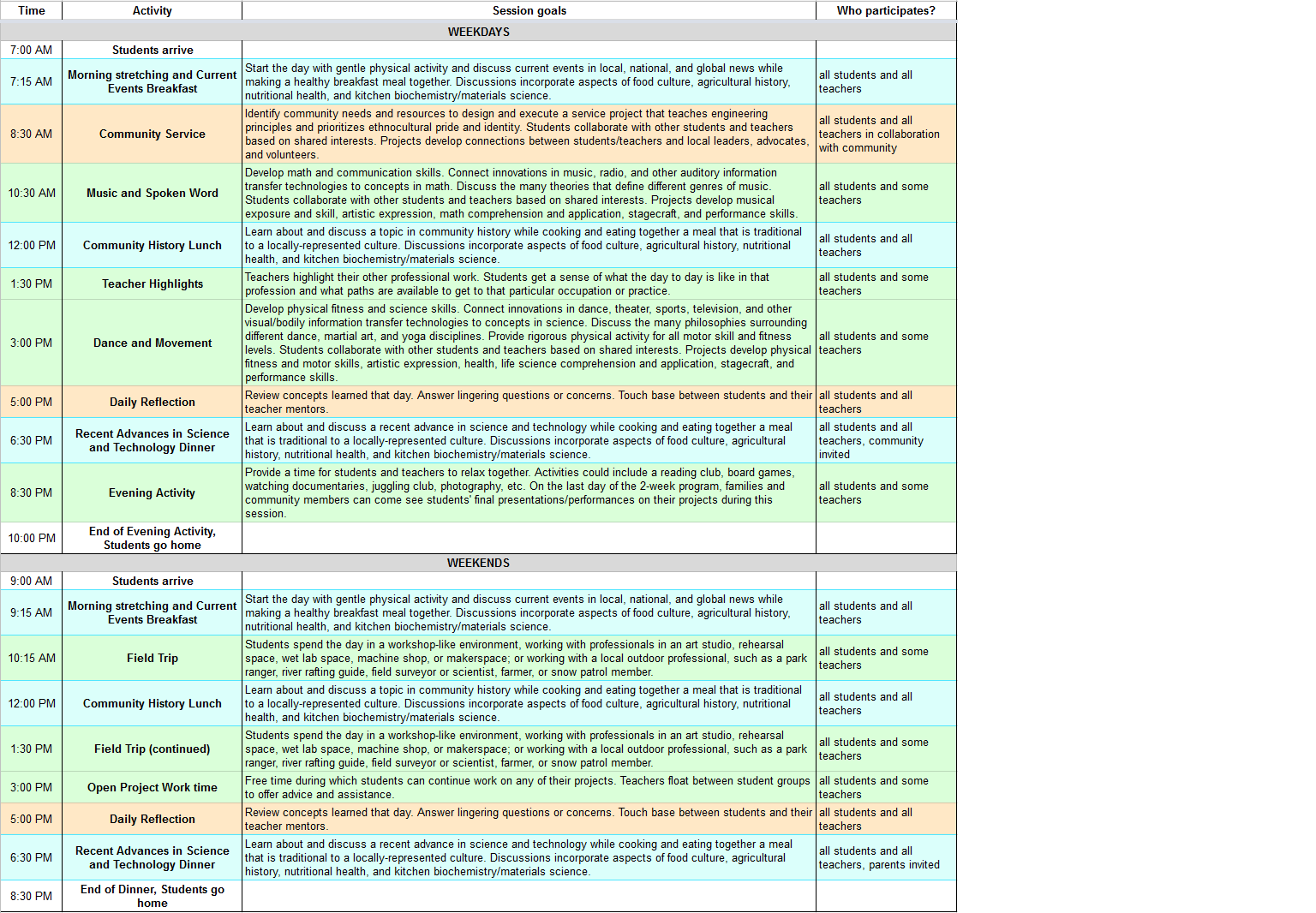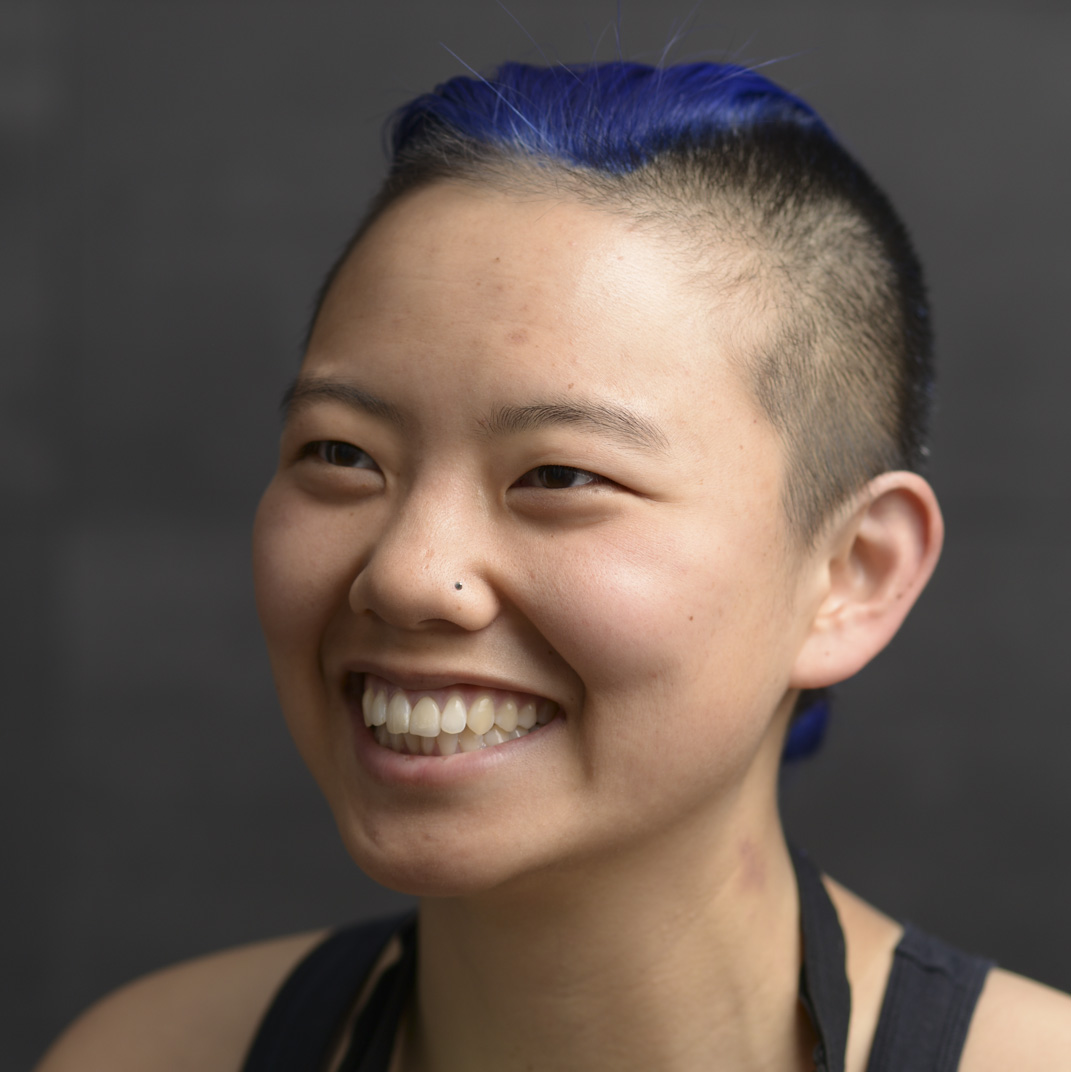The Traveling Troop of Teachers
I want to explore alternatives to the current public school system by pursuing three goals.
The first is to foster self-motivated interest in math and science by introducing youth of varying socio-economic backgrounds who are struggling in traditional school environments to local professionals and over the course of 2 weeks, share meals and collaborate on projects in dance, music, and community involvement to discover shared interests and share learning experiences. The curriculum would focus on connecting creative and technological innovations to the math, science, and communication skills required to develop these innovations, and then applying those skills to design and implement projects that teach engineering principles and promote ethnocultural pride and identity.
The second goal of this project is to foster self-motivated interest in and develop a socially widespread culture for contributing at least 2 weeks per year of a professional career to teaching. This method of teacher recruitment would be incentivized by providing monetary compensation competitive with entry-level science and engineering jobs, and creating a structure within which multiple teachers share the load of managing students throughout the day, collaboratively mentoring and learning with the students. Re-defining the roles of teachers in this way opens up the teaching pool to other professionals, and would allow teachers to teach topics of much greater personal expertise and interest, take a more active role in regularly expanding their own knowledge and experience, and provide greater emotional and intellectual support for their fellow staff. Such a structure would also provide students with daily examples of occupations outside of their socio-economic background, respectful and provocative discourse between adult peers, and behaviors that promote lifelong creative and inquisitive attitudes.
The third goal is to prioritize disadvantaged inner-city school districts in major metropolitan areas of the US such as Philadelphia, New York City, Chicago, and LA, and public school districts in poorer, more racially segregated areas of the country, such as Louisiana, Mississippi, Alabama, and Georgia.

A sample school day schedule under this new structure.
Why these three goals?
Educators, scientists, professionals, and parents have pointed out the outdated and under-serving nature of the current public education system for decades without seeing any significant structural changes to the public education system since the 1950s. “Things have changed, but not in education - why? Why is it that when we had rotary phones, whene we were having folks crippled by polio, that we were teaching the same way then taht we’re doing right now?” (“Our failing schools. Enough is enough!” 2013 TED talk by Geoffrey Canada).
For instance, in 2005 a panel of researchers and medical professionals from multiple national and international institutions examined over 850 articles, published between 1980 and 2005, to evaluate available evidence on the influence of physical activity on health and behavioral outcomes in youth 6-18 years old. The expert panel recommended that “School-age youth should participate every day in 60 minutes or more of moderate to vigorous physical activity that is enjoyable and developmentally appropriate. …Health-related activities include those that emphasize cardiovascular and muscular endurance and muscular strength and those that involve weight bearing. …The recommended 60 minutes or more of physical activity can be acheived in a cumulative manner in school during physical education, recess, intramural sports, and before and after school programs. In this regard, the Centers for Disease Control recommends daily quality physical education from kindergarten through grade 12. Both physical education and recess afford opportunities to achieve the daily physical activity goal without any evidence of compromising academic performance.” (Strong, William B., et al. “Evidence based physical activity for school-aged youth.” The Journal of Pediatrics 146.6 (2005): 732-737)
However, even with the ever-increasing collection of scientific and anectdotal evidence, “In 2013, only 99% of high school students had participated in at least 60 minutes per day of physical activity on each of the 7 days before the survey”, and “15.2% of high school students had not participated in 60 or more minutes of any kind of physical activity on any day during the 7 days before the survey.” Additionally, “The percentage of high school students who attended physical education classes daily decreased from 42% in 1991 to 25% in 1995 and remained stable at that level until 2013 (29%)” (CDC. Youth Risk Behavior Surveillance – United States, 2013. MMWR 2014;63(SS-4)).
Another review in 2007 analyzed 61 studies from between 1980 and 2004 to examine the effects of different teaching strategies on science literacy and achievement. The project concluded that two strategies, “Enhanced Context Strategies such as relating topics to previous experiences or learning and engaging students’ interest” and “Collaborative Learning Strategies such as flexible heterogeneous groupings and group inquiry projects” showed the strongest effects on student achievement in science. “Teachers can make learning relevant to students by presenting material in the context of real-world examples and problems. The real world can be brought to students through technology and students may be taken out of the classroom into the real world through field experiences. …if students are placed in an environment in which they can actively connect the instruction to their interests and present understandings and have an opportunity to experience collaborative scientific inquiry under the guidance of an effective teacher, achievement will be accelerated.” (Schroeder, Carolyn M., et al. “A meta-analysis of national research: Effects of teaching strategies on student achievement in science in the United States.” Journal of Research in Science Teaching 44.10 (2007): 1436-1460.)
While many private schools, charter schools, and some public school programs around the country utilize alternative teaching methods to great success, in 2006 the newspaper Education Week reported that the national high school graduation rate was only 69.6%, and when broken down demographically, only “51.6 percent of Black students, 47.4 percent of American Indian and Alaskan Native students, and 55.6 percent of Hispanic students graduated from high school on time with a standard diploma”. Additionally, urban versus suburban graduation rates (60% and 75%, respectively) and graduation rates in school systems with high versus low levels of racial segregation (56.2% and 75.1%, respectively) point to a shared pattern of underserving education in both poorer and more racially segregated school districts (Edwards, Virginia B. “Diplomas Count: An Essential Guide to Graduation Policy and Rates.” Education Week 25 (2006): n41S).
The new structure for learning environments and teacher recruitment that I proposed above focuses on increasing daily physical activity, teaching arts and sciences together, and increasing the resources and opportunities made available to poorer and more racially segregated school districts. As such, a sustainable implementation of this structure requires low financial overhead and maximizing the involvement and resources of the local community.
This idea could be implemented in two phases. The first phase prototypes these new learning environments and student-teacher interactions with a pilot program within the Boston metropolitan area, where I’ve been involved in the community since 2005. This prototyping process would include developing teacher certification criteria, recruiting students struggling in traditional school environments, establishing measures of growth and development in students, and interfacing this 2 week program with the traditional school year. The second phase would be to take this program to the other communities I’m interested in prioritizing, by putting together a traveling team of teachers and support staff. The traveling staff would connect with local teachers and community members and spend a 4 week cycle in each location, taking the first week to interact with the local community and develop curricula that is relevant to that community, and the last week to collect feedback, conduct interviews with students and parents, and discuss long-term plans for the traveling teachers’ continued involvement in the community.
In order to implement phase two in a sustainable way, the project needs to provide room, board, and transportation to the travelling teachers. Staying with locals, either through organizations such as Couchsurfing or through contacts made individually, would immerse the traveling teachers in the community and facilitate deeper personal bonds between the local community and the traveling teachers. Expenses for both phases would include transportation, teacher pay, food for shared meals, and materials for student projects.

Leave a Comment